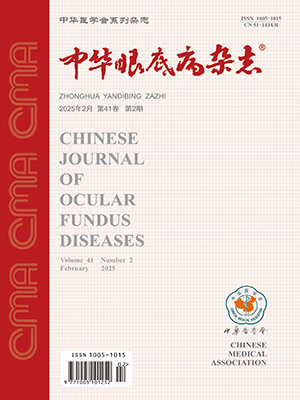| 1. |
Kumaran N, Moore AT, Weleber RG, et al. Leber congenital amaurosis/early-onset severe retinal dystrophy: clinical features, molecular genetics and therapeutic interventions[J]. Br J Ophthalmol, 2017, 101(9): 1147-1154. DOI: 10.1136/bjophthalmol-2016-309975.
|
| 2. |
Viswarubhiny S, Anjanamurthy R, Vanniarajan A, et al. Clinical exome sequencing facilitates the understanding of genetic heterogeneity in Leber congenital amaurosis patients with variable phenotype in Southern India[J]. Eye Vis (Lond), 2021, 8(1): 20. DOI: 10.1186/s40662-021-00243-5.
|
| 3. |
Li L, Xiao X, Li S, et al. Detection of variants in 15 genes in 87 unrelated Chinese patients with Leber congenital amaurosis[J/OL]. PLoS One, 2011, 6(5): e19458[2011-05-13]. https://pubmed.ncbi.nlm.nih.gov/21602930/. DOI: 10.1371/journal.pone.0019458.
|
| 4. |
Chen Y, Zhang Q, Shen T, et al. Comprehensive mutation analysis by whole-exome sequencing in 41 Chinese families with Leber congenital amaurosis[J]. Invest Ophthalmol Vis Sci, 2013, 54(6): 4351-4357. DOI: 10.1167/iovs.13-11606.
|
| 5. |
Boye SE. Leber congenital amaurosis caused by mutations in GUCY2D[J/OL]. Cold Spring Harb Perspect Med, 2014, 5(1): a17350[2014-09-25]. https://pubmed.ncbi.nlm.nih.gov/25256176/. DOI: 10.1101/cshperspect.a017350.
|
| 6. |
王诗园, 张翔, 彭婕, 等. CRB1突变型Leber先天性黑矇和早发视网膜萎缩患儿基因型与表型特征研究[J]. 中华眼底病杂志, 2021, 37(4): 284-289. DOI: 10.3760/cma.j.cn511434-20200929-00478.Wang SY, Zhang X, Peng J, et al. Genotype and phenotype of CRB1 mutated Leber congenital amaurosis and early-onset retinal atrophy[J]. Chin J Ocul Fundus Dis, 2021, 37(4): 284-289. DOI: 10.3760/cma.j.cn511434-20200929-00478.
|
| 7. |
Wang H, Wang X, Zou X, et al. Comprehensive molecular diagnosis of a large Chinese Leber congenital amaurosis cohort[J]. Invest Ophthalmol Vis Sci, 2015, 56(6): 3642-3655. DOI: 10.1167/iovs.14-15972.
|
| 8. |
Chen X, Zhao K, Sheng X, et al. Targeted sequencing of 179 genes associated with hereditary retinal dystrophies and 10 candidate genes identifies novel and known mutations in patients with various retinal diseases[J]. Invest Ophthalmol Vis Sci, 2013, 54(3): 2186-2197. DOI: 10.1167/iovs.12-10967.
|
| 9. |
Milam AH, Barakat MR, Gupta N, et al. Clinicopathologic effects of mutant GUCY2D in Leber congenital amaurosis[J]. Ophthalmology, 2003, 110(3): 549-558. DOI: 10.1016/S0161-6420(02)01757-8.
|
| 10. |
Sharon D, Wimberg H, Kinarty Y, et al. Genotype-functional-phenotype correlations in photoreceptor guanylate cyclase (GC-E) encoded by GUCY2D[J]. Prog Retin Eye Res, 2018, 63: 69-91. DOI: 10.1016/j.preteyeres.2017.10.003.
|
| 11. |
Peshenko IV, Olshevskaya EV, Dizhoor AM. Evaluating the role of retinal membrane guanylyl cyclase 1 (RetGC1) domains in binding guanylyl cyclase-activating proteins (GCAPs)[J]. J Biol Chem, 2015, 290(11): 6913-6924. DOI: 10.1074/jbc.M114.629642.
|
| 12. |
Winger JA, Derbyshire ER, Lamers MH, et al. The crystal structure of the catalytic domain of a eukaryotic guanylate cyclase[J]. BMC Struct Biol, 2008, 8: 42. DOI: 10.1186/1472-6807-8-42.
|
| 13. |
Berman HM, Westbrook J, Feng Z, et al. The protein data bank[J]. Nucleic Acids Res, 2000, 28(1): 235-242. DOI: 10.1107/s0907444902003451.
|
| 14. |
Richard M, Roepman R, Aartsen WM, et al. Towards understanding CRUMBS function in retinal dystrophies[J]. Hum Mol Genet, 2006, 15: 235-243. DOI: 10.1093/hmg/ddl195.
|
| 15. |
Pocha SM, Knust E. Complexities of Crumbs function and regulation in tissue morphogenesis[J]. Curr Biol, 2013, 23(7): 289-293. DOI: 10.1016/j.cub.2013.03.001.
|
| 16. |
Stenson PD, Ball EV, Mort M, et al. Human Gene Mutation Database (HGMD): 2003 update[J]. Hum Mutat, 2003, 21(6): 577-581. DOI: 10.1002/humu.10212.
|
| 17. |
Beryozkin A, Zelinger L, Bandah-Rozenfeld D, et al. Mutations in CRB1 are a relatively common cause of autosomal recessive early-onset retinal degeneration in the Israeli and Palestinian populations[J]. Invest Ophthalmol Vis Sci, 2013, 54(3): 2068-2075. DOI: 10.1167/iovs.12-11419.
|
| 18. |
王诗园, 赵培泉. Leber先天性黑矇分子遗传研究进展[J]. 中国实用眼科杂志, 2017, 35(7): 663-667. DOI: 10.3760/cma.j.issn.1006-4443.2017.07.002.Wang SY, Zhao PQ. Advances in molecular genetics of Leber congenital amaurosis[J]. Chin J Pract Ophthalmol, 2017, 35(7): 663-667. DOI: 10.3760/cma.j.issn.1006-4443.2017.07.002.
|




